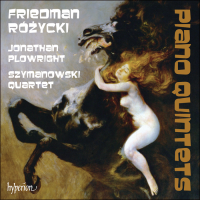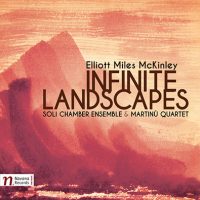String Theory 22: Ensembles with Piano
|
Grant Chu Covell [December 2016.]
Ludomir RÓŻYCKI: Piano Quintet in C minor, Op. 35 (1913). Ignacy FRIEDMAN: Piano Quintet in C minor (1918). Jonathan Plowright (pno), Szymanowski Quartet: Agata Szymczewska, Grzegorz Kotów (vln), Vladimir Mykytka (vla), Marcin Sieniawski (vlc). Hyperion CDA68124 (1 CD) (http://www.hyperion-records.co.uk/). Plowright and the Szymanowski Quartet offer a second release of Polish chamber music (piano quartets by Zarebski and Zelenski were on Hyperion CDA67905). Różycki’s lush, three-movement Quintet follows a fast-slow-fast design. The mood evolves from serious to relaxed. Generally, Różycki will use the ensemble en masse, weaving doubled strings into piano arpeggios. Różycki pivots deftly between major and minor, flirting with augmented triads. At a distance Fauré jumps to mind, although the central Adagio is nearer to Brahms. Starting cheerfully, the last movement remembers aspects of the first two movements’ darker twisting before achieving brightness. Penned the same decade, but with a different command of the forces, Friedman’s Quintet is also three movements, but proportioned as a fast movement followed by a slow one (including a fugue) capped with a shorter, fast epilogue. Given the identical key, the contrast with the more emotional, perhaps intuitive Różycki is inevitable. Both works would complement Webern’s 1907 single-movement Quintet, indeed it seems pushing harmony to its limit yet returning to tonality was in the air. These are delightfully performed Quintets, committed and secure.
“Infinite Landscapes.” Elliott Miles McKINLEY: Three Portraits (2012)1; String Quartet No. 7 (2013)2. SOLI Chamber Ensemble1: Stephanie Key (clar), David Mollenauer (vlc), Ertan Torgul (vln), Carolyn True (pno), Martinů Quartet2: Lubomír Havlák, Libor Kaňka (vln), Zbyněk Paďourek (vla), Jitka Vlašánková (vlc). Navona Records NV6040 (1 CD) (http://www.navonarecords.com/). Portraits imply static representations; however, McKinley’s threesome exhibit motion. Their titles are benign: a “Watercolor” for each of “July,” “August” and “September.” The first is a lively exploration of the ensemble as established by Messiaen. For “August,” the mood shifts suddenly from the 20th-century canon to casual blues: The music centers itself with a “Reggae-Pop” tempo marking. The third portrait continues the evolution, or discontinuity, by adding electronic beats under the slowly progressing ensemble. McKinley imposes unity in his expert handling of different materials. I also hear a philosophical sigh at the realization that traditional classical and traditional pop streams may never mix, even though they are superimposed frequently these days. McKinley’s monumental Seventh Quartet weighs in at 44 minutes. Written in memory of the Martinů’s founding violist Jan Jisa, it has six movements with contemplative titles. Several movements, such as the first, “Cathedrals of Light and Shadow,” and parts of the third, “Three Vistas,” hover around a narrow range of pitches and intervals instead of explicit melodies, emphasizing changing rhythms and harmonic shifts. Moments in “Riding into the Sky” offer minimalist quivering, recalling Adams’ Shaker Loops, except McKinley has a fully realized thematic, even visual, scope in play.
Edvard GRIEG: Piano Quintet in B-flat major, EG. 118 (1892; completed by Michael FINNISSY, 2007; rev. 2012). Michael FINNISSY: Grieg Quintettsatz (2012). Roderick Chadwick (pno), Kreutzer Quartet: Peter Sheppard Skærved, Mihailo Trandafilovski (vln), Morgan Goff (vla), Neil Heyde (vlc). Metier MSV 28541 (1 CD) (http://www.divineartrecords.com/). Completely unlike the tinkling bells which announce Berio’s divergences from Schubert, no herald indicates where Grieg ends and Finnissy begins. Finnissy follows on seamlessly from Grieg’s 234th bar to produce a sturdy 27-minute “chamber symphony,” adding scherzo-like material followed by a tranquil section and then reshaping Grieg’s ingredients into a summary and conclusion. The pulse drops immensely in the slower area, almost to immobility. As a single edifice, it may prove daunting, despite a catchy cadential sequence which signals the exposition’s end and Finnissy’s coda. In parallel, Finnissy borrowed Grieg’s material and ethos for a long winding stroll and created his Grieg Quintettsatz. If these were on opposing sides of the same LP, I could imagine a DJ making a programming mistake, confusing one for the other, as Finnissy kneads identical Scherzo material into both and indulges in Romantic lushness curiously absent from the Grieg completion. Finnissy permits the folk material to be more indigenous in his rhapsody, even though the Grieg-ish thread frequently evaporates: “I was also reminding myself of Grieg’s influence on Grainger, on Debussy and Ravel, even as remembered by John Cage.” The conclusion is unexpectedly severe. Despite exceeding the half-hour mark, I wish Finnissy had taken the coda’s startling new gestures around the block a few more times. Chadwick and the Kreutzer Quartet effortlessly navigate Grieg and Finnissy’s real and fanciful worlds. Would Finnissy attempt the same with another “old Norwegian cheese,” Grieg’s unfinished F-major String Quartet from 1891?
Ludwig van BEETHOVEN: Piano Trio in G Major, Op. 1, No. 2 (1793). Antonín DVOŘÁK: Piano Trio No. 4 in E minor, Op. 90, “Dumky” (1891). Eugene DRUCKER, Mike BLOCK, Eric GUINIVAN, Peter ERSKINE, Paul DOOLEY, Fred HERSCH, Samuel ADLER, Jim SCULLY, Christina SPINEI, Pierre JALBERT: Constellations: Variations on a Theme by Beethoven (2015). Trio Céleste: Kevin Kwan Loucks (pno), Iryna Krechkovsky (vln), Ross Gasworth (vlc). Navona Records NV6030 (1 CD) (http://www.navonarecords.com/). After a spirited and Romantic performance of Beethoven’s Op. 1, No. 2, we have ten contemporary variations on the opening phrase of the Trio’s Largo con espressione. As a set of calling cards, these new trios exhibit Trio Céleste’s breadth. I wonder whether the composers considered creating standalone pieces or efforts that would provide relative contrast from within a stream of possibly similar miniatures. Block, Erskine and Spinei explore contemporary Latin-infused dance moments. I caught the DSCH motive in Drucker’s variation. Providing welcome contrast, Dooley’s entry is for solo violin and unfurls like a cadenza. Guinivan, Adler and Jalbert suited my need for dissonance and slower motion (I did not sense either Feldman or Spectral acolytes among this decet). In contrast, the Dumky is sedate, less voluptuous than might be expected following early Beethoven, and given the prior sequence of ten casually related movements, Dvořák’s six are less cohesive than usual. Each dumka alternates subdued and energetic material, and the trio invests more shaping to the serious sections.
Adler, Beethoven, Block, Dooley, Drucker, Dvořák, EM McKinley, Erskine, Finnissy, Friedman, Grieg, Guinivan, Hersch, Jalbert, Różycki, Scully, Spinei
[More Grant Chu Covell, String Theory]
[More
Adler, Beethoven, Block, Dooley, Drucker, Dvořák, EM McKinley, Erskine, Finnissy, Friedman, Grieg, Guinivan, Hersch, Jalbert, Różycki, Scully, Spinei]
[Previous Article:
Used Bin Troll Tweets V.]
[Next Article:
EA Bucket 23.]
|



